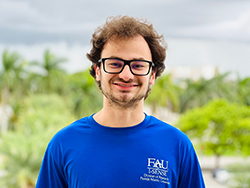Infrastructure Systems
Artificial Intelligence for Smart Cities
REU Scholar: Emily Portalatin-Mendez
REU Scholar Home Institution: Lehman College, City University of New York (CUNY)
REU Scholar: Jennifer Uraga Lopez
REU Scholar Home Institution: Lehman College, City University of New York (CUNY)
REU Mentor: Jinwoo Jang, Ph.D.
PROJECT
The Center for Smart Streetscapes (CS3) is on a mission to vitalize smart cities across the United States by creating next-generation wireless technologies, simulation awareness, and artificial intelligence (AI) applications for smart cities. Therefore, this project aims to harness a powerful 2D machine vision algorithm, combined with 3D spatial point cloud data, to estimate the social distancing behaviors of agents at a streetscape scale. Understanding those human behaviors at a streetscape level is significant to infer/identify how people interact with each other and surrounding city environments, ultimately benefiting urban planning and design. Real digital lidar data are collected and used for this study. The novelty of these data sets is that point cloud data (i.e., 3D spatial data) are correlated with 2D images/videos, which enable us to capture the 3D coordinates of objects that are detected by 2D machine vision algorithms. A convolutional neural network (CNN) was trained based on Lidar images and used to detect people. Later, the 3D coordinates of detected objects are obtained through correlated images with point cloud data, which is followed by the relative distance calculation between people based on their coordinates. The outcomes of this study have the potential to inform the development of innovative human behavior technologies for smart cities, fostering improved situational awareness and enhancing the overall urban experience.
REU Scholar: Ethan Thomas
REU Scholar Home Institution: Columbia University
REU Mentor: Jinwoo Jang, Ph.D.
Project: E-Scooter Mobility Sensing for Smart City Public Safety and Asset Management
PROJECT
In recent years, personal mobility devices, particularly e-scooters, have become an increasingly common sight in urban areas across the United States. Alongside this surge in micro-mobility device usage, concerns about road safety have emerged, driven by both the growing prevalence of these devices and the deterioration of road conditions. In response to these challenges, this project aims to create an innovative method to discern and differentiate between various riding surfaces based on electric scooters’ acceleration data. A mobile sensing device, which consists of a low-cost Inertial Measurement Unit (IMU), a GPS sensor, and a camera, was developed to collect real-world data. This research focuses on differentiating between Asphalt, Pavers (bricks), and Concrete Slabs with Expansion Joints. This classification process relies on harnessing the power of Machine Learning (ML), particularly a sophisticated Long-Short-Term-Memory (LSTM) Recurrent Neural Network. The implications of this low-cost technological breakthrough are vast and impactful. One of the critical applications lies in detecting hazardous riding surfaces, enabling timely warnings to riders and thereby enhancing overall safety. Additionally, the system can leverage GPS coordinates to identify and report roads requiring maintenance after being traversed by e-scooters, leading to more efficient infrastructure upkeep. Real e-scooter data was collected and used to validate the developed sensing system and ML algorithms.
REU Scholar: Ariana Galindo
REU Scholar Home Institution: Florida Atlantic University
REU Mentor: Jinwoo Jang, Ph.D.
Project: Spatiotemporal Data Mining and Visualization for Smart Cities
PROJECT
This project investigates the development of scalable data processing tools for large-scale spatiotemporal data. The capability to understand hidden data patterns is significant since compact but insightful, analyzed information contributes to city planning and management. The objectives of this project include 1) the development of interactive front-end 2D/3D data visualizations and 2) infrastructure integrity pattern mining. These scientific efforts were tested and validated with city-scale telematics and building inventory data. The data mined patterns are visualized on 2D/3D web maps based on single/multiple data attributes, which significantly helps visualize spatiotemporal data patterns. Data clustering is performed to handle multiple data attributes efficiently, and the result data clusters are fed into front-end map visualization tools. The web map visualization tools with data-mined patterns will significantly help urban planners and city asset management.
REU Scholar: Abigail Joseph
REU Scholar Home Institution: Florida Atlantic University
REU Mentor: Jinwoo Jang, Ph.D.
Project: Digital Twin Simulation Environment Development for Smart Cities
PROJECT
This project aims to develop data-enabled agent models and virtual simulation environments. Current transportation simulation tools cannot effectively simulate various aspects of agents' behaviors and their integrations with their surroundings. The objectives of this project include 1) the development of city infrastructure environments based on real 3D building data, 2) defining pathfinding behaviors of agents, and 3) simulations of multiple agents’ behaviors and their interactions. Unity is a cross-platform game engine that is used to "create and grow real-time 3D games, apps, and experiences for entertainment, film, automotive, architecture, and more." Integrating Unity with real data, AI technology, and C# scripting is used to create digital twin environments of West Palm Beach, where multiple agents' traveling behaviors are defined at a streetscape level. Various agent behavior parameters are implemented, including walking at a particular speed, stopping at an intersection to look for cars before crossing, and avoiding other pedestrians. This is the extent of the current research, but it is anticipated that the methods which produced these results will be used to simulate the interactions between vehicles and pedestrians with substantial accuracy.
Click here for pdf presentation
Click here to watch video presentation

Click here for pdf presentation
Click here to watch video presentation



